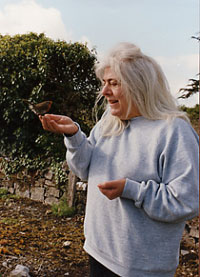
Phyllis Del Vecchio
Phyllis Del Vecchio was born in Medford, Massachusetts, USA, and studied at the Boston Museum in Fine Arts School and the Massachusetts College of Art. She taught art, painted and exhibited in the USA until 1964 when she came to Ireland on holiday. The changing light and colour in Ireland influenced her so greatly that she stayed. She has lived in Co. Galway for many years now.The West of Ireland remains her inspiration. It is the rugged wilderness we know so well, but seen in a personal and individual way. It is an intimate landscape, a hedgerow, a stream, a corner of a boreen, some trees, wild flowers. It is populated by wild birds and animals, never humans. Indeed the only human influence we see in her work is an occasional abandoned cottage, or a remote fishing lodge. It is a moody landscape, stormy and magnificent, calm and serene, damp and brooding.
By way of change her still life paintings are rich and warm in colour, more like oils than watercolours. She makes it all look so simple, and that is her great gift - her work displays rare perception and quality. She is one of the outstanding watercolourists in Ireland today.
"The higher the art the fewer the gestures" is an aphorism that could have been written especially to describe Phyllis Del Vecchio's paintings. She paints 'pure' watercolours, in which the light is reflected from the paper, having passed through the various pigments. They are translucent. She uses the white paper as the highest light, and applies transparent washes, one over another, to obtain gradations of light and colour. It is probably her best medium for working from nature, so that she can contend with changing light, and evolve a swift notation of the everyday images which she represents. It is the direct brush stoke with the watercolour, the instant fixing of a thought which she loves. Everything put on the paper stays there. This technical virtuosity allows her to express a subject directly without preplanning; there is a fluency here, a spontaneity, which can capture a moment, a mood, and yet these paintings seem timeless.